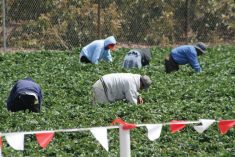The face of Canadian agriculture is changing, and farmers will need to change with it if they hope to survive.
That’s a familiar message but when Janice Goldsborough delivers it, she’s not talking about consumers — but farmers themselves.
“We have an aging population,” said Goldsborough, who helps small and medium-size businesses with their human resources issues.
“In 2011, 61 per cent of workers were over the age of 45, but our demographics are definitely changing, and it’s predicted that by the year 2025, over 30 per cent of that workforce will be retiring. That’s a huge number that will be leaving our agricultural sector.”
Read Also

Farming Smarter receives financial boost from Alberta government for potato research
Farming Smarter near Lethbridge got a boost to its research equipment, thanks to the Alberta government’s increase in funding for research associations.
That view was echoed by another expert speaking at the recent Canadian Farm Writers’ Federation conference here.
“In 2011, the 55-plus category became the largest for the first time, and that trend continued in 2016,” said Erik Dorff, a StatsCan analyst who drew from census of agriculture data.
And while the 2016 census found the number of farm operators under 35 increased three per cent from 2011 (the first increase since 1991), farming is still a tough sell to young people.
“Unfortunately, there aren’t nearly enough young people who want to take over the farms,” said Goldsborough. “It used to be automatically assumed that if you were a child growing up on a farm, you would take over that farm. That’s not always the case anymore.
“Young people aren’t seeing farming as a career of choice. They see it as long hours, a lot of work, and returns that aren’t necessarily that great.”
On average, farmers earn only about $650 a week — versus more than $900 weekly in other industries, said Goldsborough.
It’s true farm life has many other benefits above “but if you’re raising a whole family on that, that’s pretty tough,” she said. “We wonder why our young people don’t want to go into farming.”
Labour shortage
The challenge in attracting people to agriculture goes far beyond the farm.
Right now, there are about 2.3 million people working in agriculture or the agri-food sector in Canada, contributing almost $88 billion to the economy (“a phenomenal amount”), said Goldsborough.
“But of all those jobs that we have in Canada, over 26,400 in agriculture went unfilled in 2014. That cost us $1.5 billion,” said Goldsborough, drawing on numbers from the Canadian Agricultural Human Resources Council.
The council predicts that number will hit 114,000 by 2025, she added.
“If we can’t fill those positions, crops are going to go unharvested,” she said. “We have to be aware of this, and we have to look for potential solutions.”
That solution will involve more diversity — an increased number of female, Aboriginal, and foreign workers, Goldsborough predicted.
Since 1991, the proportion of male to female operators has remained relatively constant, although there was a slight uptick in 2016 and the percentage of female operators is now 28.7 per cent.
But the numbers don’t tell the whole story.
“Additionally, 25 per cent of agricultural managers are women, and that number is increasing,” she said. “And 29 per cent of people who own their own farms are women.”
Producers and processors are also working closely with bands in their area to train and recruit Aboriginal workers, she added.
“We’re looking at partnerships with Indigenous groups to help expand and look for new sources of employees who can fill these positions that are going unfilled.”
And more producers and other agribusinesses are relying on both temporary and permanent foreign workers to fill vacancies.
“It’s changing our landscape. You’re seeing the face of our communities changing. There’s diversity,” said Goldsborough.
It’s both a good thing, and a necessary shift as farmers retire and labour becomes more difficult to find, she said.
“Some people are scared of change, but change overall is a good thing,” said Goldsborough.
“It doesn’t matter who you are. The work is there, and the work needs to be done. And we need people to do it.”
Dorff agreed.
“It’s not who fills the role. It’s that the role gets filled effectively. That trumps everything else.”















